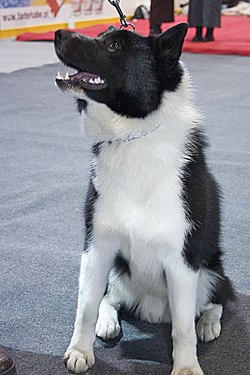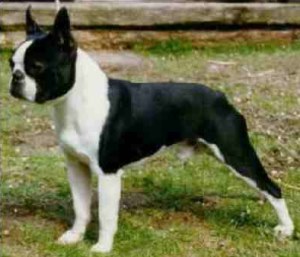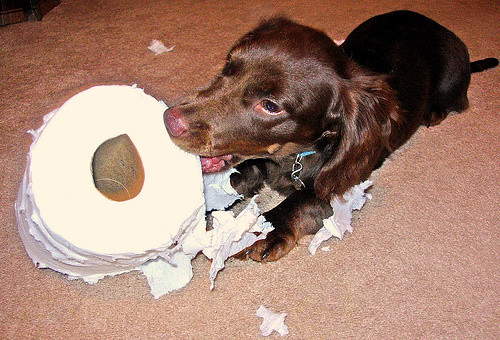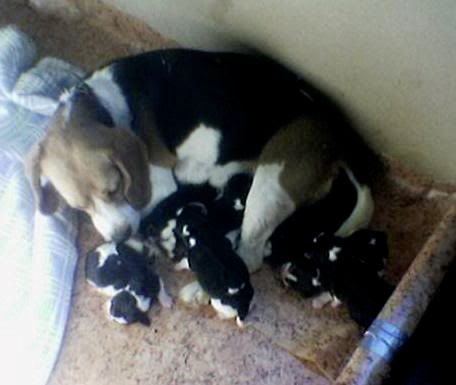
 The wolf (Canis lupus) is a mammal of the order of Carnivora. He shared a common ancestor with the domestic dog (Canis lupus familiaris), as shown by the sequence of DNA and genetic studies. [1] The wolves were once abundant and distributed by North America, Eurasia and the Middle East. Hogan, for a number of reasons related to humans, including the widespread habit of hunting, wolves inhabit only a very limited portion of that was before its territory.
The wolf (Canis lupus) is a mammal of the order of Carnivora. He shared a common ancestor with the domestic dog (Canis lupus familiaris), as shown by the sequence of DNA and genetic studies. [1] The wolves were once abundant and distributed by North America, Eurasia and the Middle East. Hogan, for a number of reasons related to humans, including the widespread habit of hunting, wolves inhabit only a very limited portion of that was before its territory.
1.Ceskoslovensky Vlcak
 Is a relatively new breed of dog. However attracts attention wherever he goes. No one doubts, nor a moment, that these dogs are those with a more distinguished origin. His mother is nature. It looks like a wolf. It is high but agile and strong. His thick coat is like a wolf including the typical mask. Do not look to the owner if not that at all times, knows exactly where he is and he is doing at all times. It puts a lot of attention around him - wants to have good views. You can easily run 100 kilometers, has a great sense of direction and reacts to the speed of light.
Is a relatively new breed of dog. However attracts attention wherever he goes. No one doubts, nor a moment, that these dogs are those with a more distinguished origin. His mother is nature. It looks like a wolf. It is high but agile and strong. His thick coat is like a wolf including the typical mask. Do not look to the owner if not that at all times, knows exactly where he is and he is doing at all times. It puts a lot of attention around him - wants to have good views. You can easily run 100 kilometers, has a great sense of direction and reacts to the speed of light.2.Finnish Spitz
 He was primarily used for hunting birds in the forest, and also for the hunting of small predators, waterfowl and elk. It is an enthusiastic hunter and more independent, but cooperating with its bark indicating the location of the dam.
He was primarily used for hunting birds in the forest, and also for the hunting of small predators, waterfowl and elk. It is an enthusiastic hunter and more independent, but cooperating with its bark indicating the location of the dam.3.Siberian Husky
 The Siberian Husky is a medium-size, dense-coat working dog breed that originated in eastern Siberia. The breed belongs to the Spitz genetic family. It is recognizable by its thickly-furred double coat, sickle tail, erect triangular ears and distinctive markings.
The Siberian Husky is a medium-size, dense-coat working dog breed that originated in eastern Siberia. The breed belongs to the Spitz genetic family. It is recognizable by its thickly-furred double coat, sickle tail, erect triangular ears and distinctive markings.4.Alaskan Malamute
 While a few Malamutes are still in use as sled dogs for personal travel, hauling freight, or helping move heavy objects, some are used for the recreational pursuit of sledding also known as mushing, also skijoring, bikejoring, and canicross. However, most Malamutes today are kept as family pets or show dogs. Although in 1994 Nancy Russell ran a team of Malamutes in the Iditarod Trail Sled Dog Race, completing 600 miles of the roughly 1,150 mile race before pulling her team, the Malamute is generally slower in long-distance dogsled racing against smaller and faster breeds and their working usefulness is limited to freighting or traveling over long distances at a far slower rate than that required for racing. They can also help move heavy objects over shorter distances.
While a few Malamutes are still in use as sled dogs for personal travel, hauling freight, or helping move heavy objects, some are used for the recreational pursuit of sledding also known as mushing, also skijoring, bikejoring, and canicross. However, most Malamutes today are kept as family pets or show dogs. Although in 1994 Nancy Russell ran a team of Malamutes in the Iditarod Trail Sled Dog Race, completing 600 miles of the roughly 1,150 mile race before pulling her team, the Malamute is generally slower in long-distance dogsled racing against smaller and faster breeds and their working usefulness is limited to freighting or traveling over long distances at a far slower rate than that required for racing. They can also help move heavy objects over shorter distances.5.Samoyed
 The Samoyed dog takes its name from the Samoyedic peoples of Siberia. An alternate name for the breed, especially in Europe, is Bjelkier. These nomadic reindeer herders bred the fluffy, white, smiling dogs to help with the herding, to pull sleds when they moved, and to keep their owners warm at night by sleeping on top of them.
The Samoyed dog takes its name from the Samoyedic peoples of Siberia. An alternate name for the breed, especially in Europe, is Bjelkier. These nomadic reindeer herders bred the fluffy, white, smiling dogs to help with the herding, to pull sleds when they moved, and to keep their owners warm at night by sleeping on top of them.6.Gronlandshund
 The Greenland Dog is a powerful, heavy-built dog. It has a broad, wedge-shaped head, slightly tilted eyes and small, triangular ears covered with thick fur that prevents frostbite. It has strong, muscular, short-haired legs. The tail is usually rolled along/across its back, but it may also hang down in a wolf like manner. When it lies down and curls up to rest, the tail often covers the nose. Its coat is of medium length and consists of two layers. The inner layer consists of short wool like fur, the outer layer of longer, coarser, water-repellent fur.
The Greenland Dog is a powerful, heavy-built dog. It has a broad, wedge-shaped head, slightly tilted eyes and small, triangular ears covered with thick fur that prevents frostbite. It has strong, muscular, short-haired legs. The tail is usually rolled along/across its back, but it may also hang down in a wolf like manner. When it lies down and curls up to rest, the tail often covers the nose. Its coat is of medium length and consists of two layers. The inner layer consists of short wool like fur, the outer layer of longer, coarser, water-repellent fur.7.Russo-European Laika
 Russo-European Laika (Russko-Evropeïskaïa Laïka) is the name of a breed of hunting dog that originated in the forested region of northern Europe and Russia, one of several breeds developed from landrace Laika dogs of very ancient Spitz type. The Russo-European Laika itself dates to a breeding program begun in 1944 by E. I. Shereshevsky of the All-Union Research Institute for the Hunting Industry, in Kalinin (now Tver) Province.
Russo-European Laika (Russko-Evropeïskaïa Laïka) is the name of a breed of hunting dog that originated in the forested region of northern Europe and Russia, one of several breeds developed from landrace Laika dogs of very ancient Spitz type. The Russo-European Laika itself dates to a breeding program begun in 1944 by E. I. Shereshevsky of the All-Union Research Institute for the Hunting Industry, in Kalinin (now Tver) Province.8.Akita Inu
 The Akita Inu, or Japanese Akita Inu (Japanese Akita) is a breed of large dog originating in Japan, named for Akita Prefecture, where it is thought to have originated. It is sometimes called the Akita-ken based on the Sino-Japanese reading of the same kanji. It is a separate breed from the Akita (American Akita), and are quite uncommon in a lot of countries.
The Akita Inu, or Japanese Akita Inu (Japanese Akita) is a breed of large dog originating in Japan, named for Akita Prefecture, where it is thought to have originated. It is sometimes called the Akita-ken based on the Sino-Japanese reading of the same kanji. It is a separate breed from the Akita (American Akita), and are quite uncommon in a lot of countries.10.Eurasier
 The Eurasier, sometimes referred to as Eurasian, is a breed of dog of spitz type that originated in Germany. It is widely known as a wonderful companion that maintains its own personality, has a dignified reserve to strangers, a strong bond to its family and that is relatively easy to train.
The Eurasier, sometimes referred to as Eurasian, is a breed of dog of spitz type that originated in Germany. It is widely known as a wonderful companion that maintains its own personality, has a dignified reserve to strangers, a strong bond to its family and that is relatively easy to train.11.Shiba Inu
 Inu is the Japanese word for dog, but the "Shiba" prefix's origin are less clear. The word shiba usually refers to a type of red shrub. This leads some to believe that the Shiba was named with this in mind, either because the dogs were used to hunt in wild shrubs, or because the most common color of the Shiba Inu is a red color similar to that of the shrubs. However, in old Japanese, the word shiba also had the meaning of "small", thus this might be a reference to the dog's small size. Therefore, the Shiba Inu is sometimes translated as "Little Brushwood Dog
Inu is the Japanese word for dog, but the "Shiba" prefix's origin are less clear. The word shiba usually refers to a type of red shrub. This leads some to believe that the Shiba was named with this in mind, either because the dogs were used to hunt in wild shrubs, or because the most common color of the Shiba Inu is a red color similar to that of the shrubs. However, in old Japanese, the word shiba also had the meaning of "small", thus this might be a reference to the dog's small size. Therefore, the Shiba Inu is sometimes translated as "Little Brushwood Dog12.Shikoku
 The Shikoku is one of the native Japanese breeds intermediate in size between the large Akita Inu and the small Shiba Inu; all are within the Spitz family of dogs. The Shikoku was bred mainly for hunting deer and boar in the mountainous districts of Kochi Prefecture. It is sometimes called "Kochi-ken" and, along with the Kai dog, referred to as a deerhound.
The Shikoku is one of the native Japanese breeds intermediate in size between the large Akita Inu and the small Shiba Inu; all are within the Spitz family of dogs. The Shikoku was bred mainly for hunting deer and boar in the mountainous districts of Kochi Prefecture. It is sometimes called "Kochi-ken" and, along with the Kai dog, referred to as a deerhound.13.Saarlooswolfhond
 The Saarloos is a fairly large dog, up to 30 inches at the shoulder and weighing up to 100 lbs. The muzzle is wide, and the ears pointed and held erect. It is an athletic dog in build, with medium bone, and a strong and muscular body. Their coat is short and dense, providing superb protection from the weather. Usually the colour of the wolf's coat, however it can vary between Black, Tan, Red, White, Silver, or Blue. The Saarloos has wolf-like expressions, as well as a wolf-like head.
The Saarloos is a fairly large dog, up to 30 inches at the shoulder and weighing up to 100 lbs. The muzzle is wide, and the ears pointed and held erect. It is an athletic dog in build, with medium bone, and a strong and muscular body. Their coat is short and dense, providing superb protection from the weather. Usually the colour of the wolf's coat, however it can vary between Black, Tan, Red, White, Silver, or Blue. The Saarloos has wolf-like expressions, as well as a wolf-like head.14.Belgian Shepherd Dog
 All are hard-working, intelligent dogs of the same general size and temperament. They differ in their coats and superficially in appearance.
All are hard-working, intelligent dogs of the same general size and temperament. They differ in their coats and superficially in appearance.They are so closely related that, when breeding any two dogs of the same coat colour and length (eg Groenendael), it is possible for puppies of different "breeds" to be in the same litter. For example, a Groenendael litter could contain a brown-coated long-haired puppy; in countries that consider them the same breed with 4 coat varieties, this is fine and the puppy would be a valid Tervuren, but the AKC considers it to be an aberration of the all-black Belgian Shepherd and disqualifies it in the conformation ring.


 The Boston Terrier is a small dog, expression serious, happy and playful behavior. During the years 1929 to 1935 was the most popular breed in the United States. At present, besides being an excellent companion dog and serve as a mascot to a myriad of schools and sports teams, is employed with great success in therapy for people with physical or mental difficulties.
The Boston Terrier is a small dog, expression serious, happy and playful behavior. During the years 1929 to 1935 was the most popular breed in the United States. At present, besides being an excellent companion dog and serve as a mascot to a myriad of schools and sports teams, is employed with great success in therapy for people with physical or mental difficulties.



















 These guidelines are not a complete guide to raising a puppy (there are whole books devoted to that topic!) But here you’ll find a good start. The text is ready along a timeline, beginning at 8 weeks, the earliest age at which most people would be carrying a puppy to his house. If your puppy has more age and you lost the earliest stages (or you do not know what happened during them)
These guidelines are not a complete guide to raising a puppy (there are whole books devoted to that topic!) But here you’ll find a good start. The text is ready along a timeline, beginning at 8 weeks, the earliest age at which most people would be carrying a puppy to his house. If your puppy has more age and you lost the earliest stages (or you do not know what happened during them)








 Should already know that the dog should always be fighting just when you're doing something you should not, if you do not then you will understand, will not do any good.
Should already know that the dog should always be fighting just when you're doing something you should not, if you do not then you will understand, will not do any good. 

 because when we say that a dog is dominant we are also speaking to our level of leadership in this pack.
because when we say that a dog is dominant we are also speaking to our level of leadership in this pack.